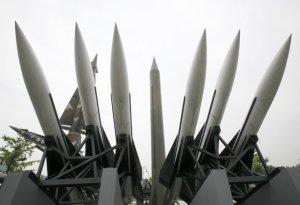 Mock Scud-B missiles on display at the Korean War Museum in Seoul. (Source: AP Photos)
Mock Scud-B missiles on display at the Korean War Museum in Seoul. (Source: AP Photos)
By Kathleen E. Masterson
South Korea and the United States have recently entered working-level talks to discuss extending the range of South Korea's missiles. A decade ago Seoul successfully lobbied Washington for entry into the Missile Technology Control Regime (MTCR), an informal coalition of 34 states committed to limiting the proliferation of ballistic missiles and other unmanned delivery systems capable of delivering weapons of mass destruction. At the time Washington was hesitant to allow the South into the regime, largely due to Seoul's history of responding to Pyongyang's military advancements by pursuing missile ambitions of its own. As the condition for entry into the MTCR, Washington demanded additional limitations be placed on the ranges of South Korea's missiles, yet even then the United States did not trust Seoul to adhere to the missile restrictions.
American concerns are not without merit. The South's decision to obtain dual-use rockets from Russia for its first space launch in 2009 underscores the validity of Washington's misgivings. The technology agreement between Seoul and Moscow may have adhered to the letter of the MTCR, but not its spirit. Now, however, reports are circulating that Seoul has already developed missiles that far exceed the range limits laid out under the bilateral agreement between South Korea and the United States. Seoul recently developed Hyunmu 3C cruise missiles capable of traveling up to 1500 kilometers, allowing the South to attack virtually any site on the Korean peninsula and even placing areas of China and Russia within Seoul's range. As South Korean defense analyst Shin In-kyun said in an interview with The Korea Herald, "The missile is not just for a war. It is meaningful in that we have secured deterrence capabilities." Unlike the ambiguity surrounding Seoul's cooperative efforts with Moscow, such a development, if true, would constitute a blatant breach of South Korea's commitments to the United States.
American protection offers a large degree of deterrence, and South Korea's alliance with the United States may have been the deciding factor in maintaining the unstable peace on the peninsula. However, with South Korea scheduled to resume control over operational command (OPCON) of its wartime forces in 2015, Seoul may believe that developing indigenous counter-force capabilities is in the best interest of its national security.
Seoul's concerns over the looming OPCON transfer aside, increasing tensions on the Korean peninsula have also given South Korea plenty of reasons to want to renegotiate its missile limitations. The power balance between North Korea's military strength and the South's has been completely upended since South Korea joined the MTCR in 2001. During that time, North Korea has tested two nuclear weapons and taken increasingly provocative actions against its southern counterpart. In 2010 alone, North Korea sank the ROKS Cheonan, shelled the South Korean border island of Yeonpyeong, and unveiled a pilot centrifuge plant for its nuclear weapons program.
Underlying these bold provocations is the recognition on both sides of North Korea's missile superiority. With approximately 600 short-range Scud missiles and 200 Nodong missiles capable of traveling up to 1300 kilometers, North Korea possesses missile capabilities that far outstrip its southern counterpart.
The United States military has its own regional concerns that may be alleviated by allowing South Korea to renegotiate its missile range. North Korea is believed to possess intermediate-range missiles capable of reaching U.S. territory, including Alaska and Guam, albeit likely in limited numbers. Additional deterrence from South Korea, therefore, may be mutually beneficial for the allies. Top U.S. officials have also expressed concern over North Korea's intercontinental ballistic missile program, with Secretary of Defense Gates identifying Pyongyang's incipient development of an ICBM as a "direct threat" to the United States' security.
On the other hand, allowing South Korea to sidestep its commitments makes it more difficult for the United States to impose missile limitations on other states seeking to expand their capabilities. Efforts to stymie missile proliferation have already been weakened by uneven missile controls and weak norms. Several MTCR member states have already made a distinction between ballistic and cruise missiles, placing a greater emphasis on halting ballistic missile proliferation and placing a lower priority on limiting cruise missiles and UAVs. By allowing the South Koreans to develop missile technology with such a long range despite its membership in the MTCR and its existing bilateral agreements with the United States, Washington would create yet another exception to the already weak missile nonproliferation regime.
South Korea remains an important U.S. ally -- politically, economically, and militarily -- and the threat it faces from the North is very real. Yet missile proliferation also presents a significant risk, not only to the United States and South Korea, but to U.S. allies across the globe. In the upcoming talks with Seoul, Washington must strike a delicate balance between upholding the international missile nonproliferation regime and addressing South Korea's security concerns.
